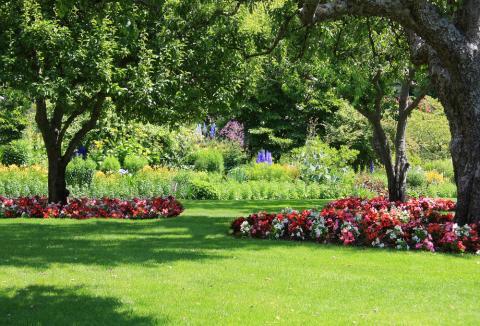
Not everyone that loves to garden is blessed with a sunny backyard. For those with yards covered by trees, surrounded by fences, or facing north, sunshine is the only thing your plant is missing. That doesn’t mean you’re confined to sword ferns and swaths of moss. Planting a beautiful flower garden is still possible, if you learn to love shade-loving plants and flowers. Ditch your vision of sunflowers and dahlias and grow these sweet blooms instead.
Hosta
Hosta, also known as plantain lilies, are hardy plants that work especially well for shady areas. While some tolerate small amounts of sun, most thrive in the shade. Plant them around walkways or tucked behind showier blooms; there are several varieties to choose from, with colors ranging from chartreuse to dusty blue.
Euphorbia
Euphorbia, commonly known as spurge, is a common plant in the Pacific Northwest U.S. where it’s planted in otherwise drab front yards. More alien-looking than anything you’ve probably seen, this quirky plant includes everything from the Euphorbia epithymoides with punchy yellow “flowers” to the red flowering Euphorbia milli of Madagascar.
Begonia
Begonias are a popular choice for sun-lacking gardens, thanks to their pops of color. These annuals can be planted in the spring, and maintain blooms through spring, summer, and fall. While you probably don’t want to plant them in the backyard, begonias work well in planters and as features in a front yard display. Better still, they range in colors from pink and purple to white and red.
Hydrangea
Hydrangea are large bushes most frequently seen with blue or pink flowers. These popular plants bloom throughout summer and fall, and can change color depending on the acidity of your soil. Hoping for blue hues? Maintain a soil acidity of less than 5.5 pH. Dreaming of pink? Aim for a pH of 5.5 and above. Soils somewhere in between will often produce a purple-type color.
Bleeding Heart
Bleeding heart is often sold as a hanging plant and while it might look as though it comes from a tropical island thanks to its bright pink flower-heart leaves (hence its name), this perennial loves shade. While several varieties exist, the less-colorful (though just as pretty) formosa bleeding heart is native to the Northwest U.S.
Columbine
This delicate perennial is my personal favorite thanks to the variety of colors, sizes, and shapes you can grow. Look for bright red, orange, and yellow flowers to more subtle blues, whites, and purples, and sizes from 15 inches to 3 feet, depending on the species. As a more fragile plant, these work best next to walkways or in front yards where they can be best admired.
Trillium
Trillium is a three-flowered white perennial that grows abundantly in the forests of the Pacific Northwest. Naturally shade-loving, this plant blooms in early spring. Since you should never pick trillium in the wild (most are threatened, if not endangered), planting them at home encourages their conservation.
Peony
My father’s favorite flower is the peony, and for good reason: they smell amazing. These tall, elegant flowers bloom in a multitude of colors and are hardy perennials that come back year after year without much maintenance. For best results, plant these in the fall to get blooms in the spring; another option is to purchase already-blooming peonies from your local nursery.
Your Native Plants
Many of the plants mentioned on this list are natives of the Pacific Northwest, and while they work well in many regions across the United States, check out your local nursery’s options! Native plants attract butterflies, birds, and other important pollinators to your backyard. Additionally, most require far less water than their non-native counterparts.








